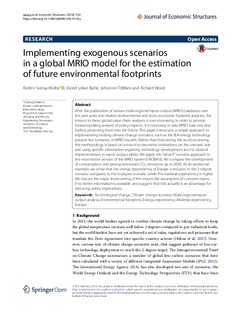| dc.contributor.author | Wiebe, Kirsten Svenja | |
| dc.contributor.author | Bjelle, Eivind Lekve | |
| dc.contributor.author | Többen, Johannes Reinhard | |
| dc.contributor.author | Wood, Richard | |
| dc.date.accessioned | 2019-09-06T09:06:48Z | |
| dc.date.available | 2019-09-06T09:06:48Z | |
| dc.date.created | 2018-11-21T16:07:29Z | |
| dc.date.issued | 2018 | |
| dc.identifier.citation | Journal of Economic Structures. 2018, 7 (20), . | nb_NO |
| dc.identifier.issn | 2193-2409 | |
| dc.identifier.uri | http://hdl.handle.net/11250/2612896 | |
| dc.description.abstract | After the publication of various multi-regional input–output (MRIO) databases over the past years and related environmental and socio-economic footprint analyses, the interest in these global value chain analyses is ever increasing. In order to provide forward-looking analysis of policy impacts, it is necessary to take MRIO data one step further, projecting them into the future. This paper introduces a simple approach to implementing existing climate change scenarios, such as the IEA energy technology perspective scenarios, in MRIO models. Rather than forecasting the world economy, the methodology is based on a mix of econometric estimations on the demand side and using specific information regarding technology development and its classical implementation in input–output tables. We apply this “what if” scenario approach to the most recent version of the MRIO system EXIOBASE. We compare the development of consumption- and production-based CO2 emissions up to 2030. As an additional example, we show that the energy dependency of Europe is reduced in the 2-degree scenario compared to the 6-degree scenario, while the material dependency is higher. We discuss the major shortcoming of the model, the assumption of constant shares if no better information is available, and suggest that this actually is an advantage for deducing policy implications. | nb_NO |
| dc.language.iso | eng | nb_NO |
| dc.publisher | Springer Verlag | nb_NO |
| dc.relation.uri | https://doi.org/10.1186/s40008-018-0118-y | |
| dc.rights | Navngivelse 4.0 Internasjonal | * |
| dc.rights.uri | http://creativecommons.org/licenses/by/4.0/deed.no | * |
| dc.title | Implementing exogenous scenarios in a global MRIO model for the estimation of future environmental footprints | nb_NO |
| dc.type | Journal article | nb_NO |
| dc.type | Peer reviewed | nb_NO |
| dc.description.version | publishedVersion | nb_NO |
| dc.source.pagenumber | 18 | nb_NO |
| dc.source.volume | 7 | nb_NO |
| dc.source.journal | Journal of Economic Structures | nb_NO |
| dc.source.issue | 20 | nb_NO |
| dc.identifier.doi | 10.1186/s40008-018-0118-y | |
| dc.identifier.cristin | 1633440 | |
| dc.description.localcode | © The Author(s) 2018. This article is distributed under the terms of the Creative Commons Attribution 4.0 International License (http://creativecommons.org/licenses/by/4.0/) | nb_NO |
| cristin.unitcode | 194,64,25,0 | |
| cristin.unitname | Institutt for energi- og prosessteknikk | |
| cristin.ispublished | true | |
| cristin.fulltext | original | |
| cristin.qualitycode | 1 | |

